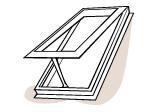
When thinking about vents it’s easy to get caught up in the details and forget that the most effective ventilation in a home almost always comes from its windows.
Windows are an excellent source of natural ventilation, and a crucial factor not just in wind-driven and stack ventilation methods, but also in some mechanically driven ventilations systems (like those requiring a whole house fan).

If you plan on ventilating your home using wind-driven ventilation, the orientation of your home and its windows should be designed to make the most of prevailing winds. Coastal breezes usually come from an onshore direction. In mountainous or hilly areas, cool breezes often flow down valleys in late evening and early morning as night cooling creates cool air currents.
How effective are windows for ventilation?
The effectiveness of windows to achieve good ventilation relies on which windows are opened and how far they are opened. Windows with large opening areas and doors that open fully will increase the passage of breezes. Operable hinged windows such as louvres and casement windows allow ventilation through the full window area, while sliding windows such as double hung and horizontal sliding windows can only be opened to, at most, half the window area.
In addition, the faster air can travel, the more effective it becomes for the purposes of cooling and ventilation. Obstacles in the path of moving air will cause it to change direction and slow down. To maximise the cooling effect of breezes through windows, keep obstructions such as trees, shrubs or fences on the outside to a minimum and consider the internal layout of walls and furniture.
For further information about windows, visit the BUILD windows site.
|
Advantages
|
Disadvantages
|





